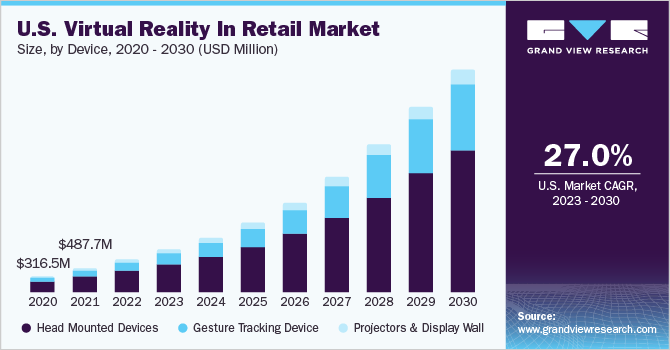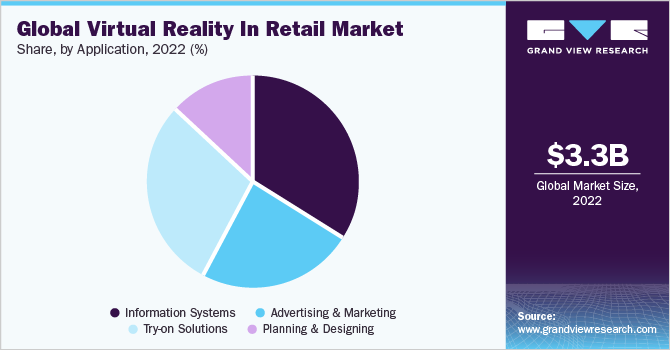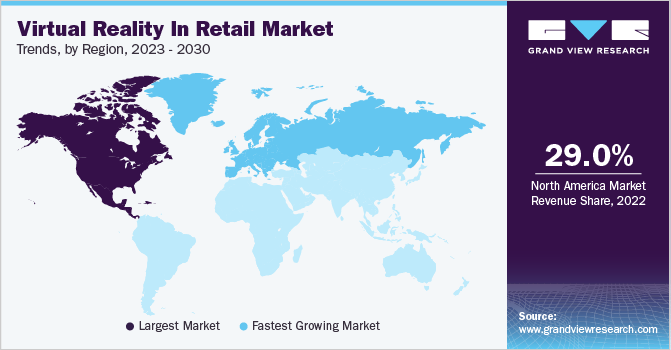- Home
- »
- Next Generation Technologies
- »
-
Virtual Reality In Retail Market Size And Share Report, 2030GVR Report cover
![Virtual Reality In Retail Market Size, Share & Trends Report]()
Virtual Reality In Retail Market (2023 - 2030) Size, Share & Trends Analysis Report By Component (Hardware, Software, Services), By Device (Head Mounted Devices, Gesture Tracking Device), By Application, By Vertical, By Region, And Segment Forecasts
- Report ID: GVR-4-68040-086-7
- Number of Report Pages: 150
- Format: PDF
- Historical Range: 2018 - 2021
- Forecast Period: 2023 - 2030
- Industry: Technology
- Report Summary
- Table of Contents
- Interactive Charts
- Methodology
- Download FREE Sample
-
Download Sample Report
Virtual Reality In Retail Market Summary
The global virtual reality in retail market size was valued at USD 3.25 billion in 2022 and is expected to reach USD 23.69 billion by 2030, growing at a CAGR of 28% from 2023 to 2030. The growing trend of VR headsets in the retail sector is reshaping the customer shopping experience, resulting in a rapid market expansion during the forecast period.
Key Market Trends & Insights
- North America accounted for a significant revenue share of 29% in 2022.
- The European region is anticipated to exhibit the fastest CAGR from 2023 to 2030.
- By component, the software segment is expected to expand the highest CAGR of 29.7% over the forecast period.
- By device, the head-mounted Devices (HMDs) segment accounted for the highest revenue share of 64.0% in 2022.
- By vertical, the food and beverage segment is expected to record a CAGR of 33.0% from 2023 to 2030.
Market Size & Forecast
- 2022 Market Size: USD 3.25 Billion
- 2030 Projected Market Size: USD 23.69 Billion
- CAGR (2023-2030): 28%
- North America: Largest market in 2022
- Europe: Fastest growing market
Moreover, various companies are attempting to bring VR shopping experience into their outlet and website as it enhances the user buying experience. For instance, in August 2022, Hugo Boss AG launched a virtual reality try-on service dressing room allowing online customers to try clothes with the help of personalized avatars, such strategies of players is boosting the market growth over the forecast period.
Additionally, the implementation and integration of Artificial Intelligence (AI), machine learning, and the Internet of Things (IoT) into virtual reality are likely to augment the demand for virtual reality in the retail market. For instance, in February 2023, Procter & Gamble Company, a multinational consumer goods company, is expected to launch a supply chain platform for its retail partners across North America. The company is tapping virtual reality tools, proprietary algorithms, and artificial intelligence to upscale its business and generate better insights, which is expected to drive virtual reality in retail market growth.
The COVID-19 pandemic has had a profound impact on the virtual reality in the retail market. As consumers turned to online shopping, retailers sought innovative ways to provide an immersive shopping experience, leading to increased adoption of VR technology. Virtual reality has allowed retailers to bridge the gap between physical and online shopping by offering interactive product visualization, virtual try-on, and simulated store environments. The pandemic has accelerated the integration of VR in retail, as it enables customers to engage with products and brands in a realistic and immersive manner, even from the comfort of their own homes. This shift in consumer behavior and the growing need for enhanced online shopping experiences have further propelled the virtual reality market in the retail market.

The adoption of Virtual Reality (VR) in the retail sector offers customers personalized information and experiences, contributing to its growing popularity. Through VR technology and headsets, customers can customize their shopping experience by virtually experiencing products or services. For instance, using virtual tools, a customer can personalize and customize clothing according to their preferences before making a purchase. This level of personalization is anticipated to drive the demand for virtual reality in the retail market in the forecast period.
Moreover, the utilization of VR in retail not only enables an immersive shopping experience but also generates valuable data for marketing analytics teams to enhance customer experience and increase brand awareness. This data-driven approach is expected to drive the growth of the virtual reality in retail market in the forecast period. Furthermore, technological advancements, such as the incorporation of eye-tracking technology in VR headsets, provide retailers with insights into customer preferences and buying patterns. This understanding of consumer behavior fuels the demand for virtual reality in retail as it helps retailers optimize their product offerings.
Component Insights
The software segment is expected to expand the highest CAGR of 29.7% over the forecast period, owing to the ongoing innovations and technological developments in the virtual reality in retail market. Virtual reality software allows customers to visualize products in a realistic and immersive manner before making the decision to purchase. By integrating high-quality 3D modeling and rendering capabilities, the software enables retailers to showcase the product from multiple angles in different sizes, colors, and configurations. This, in turn, is expected to augment the segmental growth over the forecast period.
The hardware segment accounted for the largest revenue share in 2022, owing to the notable focus on advancing headsets to enhance display resolution, comfort, and overall performance. Moreover, the eye-tracking technology is being integrated to gather valuable consumer insights, and gesture and motion tracking enhance user interaction. Additionally, there is a demand for scalable and affordable VR solutions to accommodate a wider range of retailers and customers, driving innovation in the hardware segment of the virtual reality in retail market.
Device Insights
The Head-mounted Devices (HMDs) segment accounted for the highest revenue share of 64.0% in 2022 and is expected to continue the same trend over the forecast period. The increasing popularity of VR headsets, such as Oculus Rift, HTC Vive, and PlayStation VR, among consumers is driving the growth of the HMDs segment. These headsets provide immersive experiences and are widely adopted for various retail applications, including virtual product demonstrations, virtual try-ons, and virtual store visits. As the technology advances and prices become more affordable, the demand for HMDs is anticipated to grow, further consolidating the segment's position as a major revenue generator in the VR retail market.
The gesture tracking device segment is expected to register a significant growth rate over the forecast period. The increasing adoption of gesture tracking technologies, such as hand tracking and motion sensors, is driving the segment growth. These devices enable users to interact with virtual environments and manipulate virtual objects using natural hand movements and gestures. In the retail context, gesture tracking devices offer a seamless and intuitive way for customers to navigate virtual stores, select products, and engage with virtual content, which is expected to drive the gesture-tracking device segment growth during the forecast period.
Vertical Insights
The food and beverage segment is expected to record a CAGR of 33.0% from 2023 to 2030, owing to the emergence of virtual dining experiences. The customers can immerse themselves in virtual restaurant settings, explore menus, and even interact with virtual waitstaff. This trend offers a unique and engaging way for customers to preview and experience dining options before making reservations or ordering food, enhancing the overall dining experience and driving the growth of VR in the food and beverage retail market.
The clothing segment witnessed a significant revenue share for the virtual reality in retail market in 2022. Virtual reality is revolutionizing the clothing segment by offering innovative technologies for customers to interact with their desired products, enabling brands to showcase their product portfolio, and enhancing the shopping experience. Furthermore, the implementation of VR technology in the retail sector is experiencing increased demand as it effectively enhances customer engagement on websites, particularly for specific products. This increased level of customer engagement has a direct impact on buying decisions, driving market growth and further fueling the adoption of VR in the retail market.
Application Insights
The planning and designing segment is expected to record the highest CAGR of 29.2% from 2023 to 2030. This is attributed to the properties offered by the virtual reality for the retail industry, such as store design and layout, store prototype designing, and visual merchandising, among others. In addition, the VR technology helps retailers to visualize and create virtual store layouts and designs before implementing them in physical spaces. Retailers can also get the leverage to experience shelving arrangements, product placement, and design alterations, which is expected to further drive the virtual reality in retail market growth during the forecast period.

The advertising and marketing segment witnessed a significant revenue share for the virtual reality in retail market in 2022 and is expected to record significant growth in the coming years. The growing trend of brand differentiation, increasing market presence, improved product visualization, targeted campaigns, and valuable insights in companies by implementing virtual reality in retail, are expected to fuel the market growth over the forecast period. Moreover, the virtual reality technology collects a large amount of data and analytics insights that can be used for refined marketing strategies and optimizing product offerings, among others. This, in turn, is expected to boost the segmental growth over the forecast period.
Regional Insights
North America accounted for a significant revenue share of 29% in 2022 and is expected to continue its dominance from 2023 to 2030. This is attributed to the increased digitalization and virtual reality technology developments in the region. Additionally, the high disposable income levels and weakening prices of headsets with screens and processors are expected to fuel the market growth across the region. Furthermore, the growing demand for improved customer buying experience and the rising competitiveness among retailers in the region is further expected to drive the virtual reality in retail market growth.

The European region is anticipated to exhibit the fastest CAGR from 2023 to 2030. The market growth is attributed to the presence of numerous notable fashion brands that are implementing virtual reality to enhance the customer experience along with increasing their brand presence. In addition, the rising preference for remote shopping, as it helps customers with personalized shopping experiences with the availability of a vast product portfolio, is expected to propel the virtual reality in retail market growth further across the region.
Key Companies & Market Share Insights
The market is classified as highly competitive, with the presence of several virtual reality in retail market players. The key players operating in the virtual reality in retail industry are focusing on strategic alliances, mergers & acquisitions, expansion, and product development to remain competitive in the industry. For instance, in April 2023, Obsess, Inc., a virtual store platform for experiential e-commerce, launched a self-service virtual store for brands. This gives brands the ability to build their own virtual stores along with a customizable 3D e-commerce experience. This, in turn, is anticipated to augment the virtual reality in retail market growth over the forecast period. Some of the key players in the global virtual reality in retail market include:
-
Visualise Creative Ltd.
-
VREI
-
Panedia Pty Ltd
-
Fieback Medien
-
FireBirdVR
-
FXGear Inc.
-
Koncept VR
-
Matterport, Inc.
-
Subvrsive, Inc.
-
VIAR
-
WeMakeVR
-
Scapic Innovations Pvt. Ltd.
Virtual Reality In Retail Market Report Scope
Report Attribute
Details
Market size value in 2023
USD 4.21 billion
Revenue forecast in 2030
USD 23.69 billion
Growth rate
CAGR of 28.0% from 2023 to 2030
Base year for estimation
2022
Historical data
2018 - 2021
Forecast period
2023 - 2030
Quantitative units
Revenue in USD million and CAGR from 2023 to 2030
Report coverage
Revenue forecast, company ranking, competitive landscape, growth factors, and trends
Segments covered
Component, device, application, vertical, region
Regional scope
North America; Europe; Asia Pacific; South America; Middle East & Africa
Country scope
U.S.; Canada; Mexico; Germany; U.K.; France; Italy; China; India; Japan; South Korea; Brazil; Argentina; South Africa; Saudi Arabia
Key companies profiled
Visualise Creative Ltd.; VREI; Panedia Pty Ltd; Fieback Medien; FireBirdVR; FXGear Inc.; Koncept VR; Matterport, Inc.; Subvrsive, Inc.; VIAR; WeMakeVR; Scapic Innovations Pvt. Ltd.
Customization scope
Free report customization (equivalent to up to 8 analyst working days) with purchase. Addition or alteration to country, regional & segment scope.
Pricing and purchase options
Avail customized purchase options to meet your exact research needs. Explore purchase options
Global Virtual Reality In Retail Market Report Segmentation
This report forecasts revenue growth at global, regional, and country levels and provides an analysis of the latest industry trends in each of the sub-segments from 2018 to 2030. For the purpose of this study, Grand View Research has segmented the global virtual reality in retailmarket report on the basis of component, device, application, vertical, and region:
-
Component Outlook (Revenue, USD Million, 2018 - 2030)
-
Hardware
-
Software
-
Services
-
-
Device Outlook (Revenue, USD Million, 2018 - 2030)
-
Head Mounted Devices
-
Gesture Tracking Device
-
Projectors & Display Wall
-
-
Application Outlook (Revenue, USD Million, 2018 - 2030)
-
Information Systems
-
Advertising & Marketing
-
Try-on Solutions
-
Planning & Designing
-
-
Vertical Outlook (Revenue, USD Million, 2018 - 2030)
-
Food and Beverage
-
Home Products
-
Clothing
-
Consumer Electronics
-
-
Regional Outlook (Revenue, USD Million, 2018 - 2030)
-
North America
-
U.S.
-
Canada
-
Mexico
-
-
Europe
-
Germany
-
UK
-
France
-
Italy
-
-
Asia Pacific
-
China
-
Japan
-
India
-
South Korea
-
-
South America
-
Brazil
-
Argentina
-
-
Middle East & Africa (MEA)
-
South Africa
-
Saudi Arabia
-
-
Frequently Asked Questions About This Report
b. The global virtual reality in retail market size was valued at USD 3.25 billion in 2022 and is expected to reach USD 4.21 billion in 2023.
b. The global virtual reality in retail market is expected to grow at a compound annual growth rate of 28% from 2023 to 2030 to reach USD 23.69 billion by 2030.
b. The head mounted devices segment registered the highest revenue share of over 64% in 2022 in the virtual reality in retail market and is expected to continue dominating the industry over the forecast period.
b. The key players in virtual reality in retail market includes Visualise Creative Ltd.; VREI; Panedia Pty Ltd; Fieback Medien; FireBirdVR; FXGear Inc.; Koncept VR; Matterport, Inc.; Subvrsive, Inc.; VIAR; WeMakeVR; Scapic Innovations Pvt. Ltd.
b. The growing trend of VR headsets in the retail sector is reshaping the customer shopping experience and the implementation and integration of Artificial Intelligence (AI), Machine Learning (ML), and the Internet of Things (IoT) into virtual reality are likely to augment the demand for virtual reality in the retail market over the forecast period.
Share this report with your colleague or friend.
Need a Tailored Report?
Customize this report to your needs — add regions, segments, or data points, with 20% free customization.

ISO 9001:2015 & 27001:2022 Certified
We are GDPR and CCPA compliant! Your transaction & personal information is safe and secure. For more details, please read our privacy policy.
Trusted market insights - try a free sample
See how our reports are structured and why industry leaders rely on Grand View Research. Get a free sample or ask us to tailor this report to your needs.










